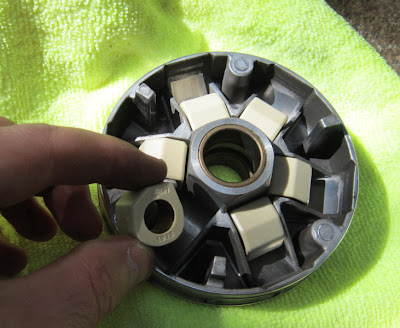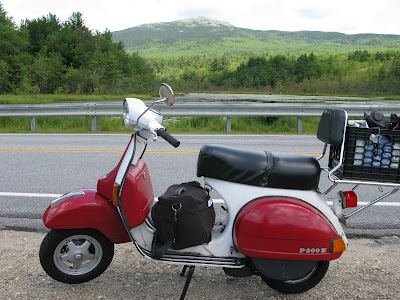My temporary solution (and it took me longer to get around to fixing than it should have...) was to unplug the green kill wire from the CDI at the back of the engine. This allowed me to run the scooter... but of course when the green wire is unplugged, then you can't turn the scooter off! So, for the last couple of weeks I've been turning the scooter off by popping the cowl off the engine side and reconnecting the green kill switch wire to the CDI. Engine dies, then I pull the wire back off and the scooter is ready to be started again.
But this was ridiculous - imagine having to pop the hood of your car in every parking lot you stop in to turn the engine off! I get enough looks as it is on a 34 year old Vespa scooter.
So I ordered a new kill switch, and today I finally got around to replacing it. I took some pictures and thought I would share how it is done for those who are curious - chances are you'll need to do it at some point because if the switch doesn't physically break like mine did, the wiring will probably crumble and short out eventually on these old machines, prompting a similar problem.
From a conceptual standpoint, replacing the kill switch is super easy - all you need is a Phillips screwdriver, some sturdy twine, and a new kill switch. But if you don't have the twine, it will be very difficult and annoying, as I will explain in a minute.
Step 1:
Remove the horncast - this is very easy: take the tiny screw out of the black plastic Piaggio emblem at the top of the horncast, remove the emblem. This exposes two larger screws that hold the top of the horncast against the frame. Remove these, and remove their counterparts hiding inside the glovebox that hold the bottom of the horncast against the frame. Then unplug the two wires from the horn and you can lift the horncast off and set it aside. This exposes this junction box:
The junction box connects the left and right handlebar switches to the rest of the wiring loom.
Step 2:
Remove the upper headset by unscrewing the two screws on the underside of each handlebar:
Then to lift the headset up, you create slack in the speedo cable by pushing the excess cable up into the fork (you don't need to disconnect it from the hub - there is enough slack to get the headset up far enough to work on). Simply grab the cable as shown here and gently push it toward the fork arm:
Up at the headset, this slack will allow you to lift the upper headset up enough to reach your hand in and unscrew the ring nut holding the speedo cable against the speedometer. I've wrapped a little duct tape around the top of the cable just below the ring nut to prevent the nut from sliding down the cable and getting lodge inside the fork (what a pain when that happens!)... a rubber band or somesuch would work as well.
Once the speedo cable is free from the speedometer, you can lift the headset away and let it dangle from the wires - try to be gentle so as not to break anything, and try not to disconnect the wires from the top of the headset, otherwise you'll need to reference a wiring diagram to figure out what goes where.
At this point you can peek around the front of the scooter while tugging on the wiring running from the kill switch and you'll be able to see which pair of wires going into the junction box is the one you need to disconnect (hint, it's the green, blue, brown, white, and black set of wires):
Step 3:
Go ahead and unplug the kill switch wires from the wiring loom in the junction box. But do NOT start pulling the wires up and out of the frame! Think about it: when you put the new kill switch in place, you are going to have to feed its wires down through the frame back to this location. And pushing wires through tight spaces does not work well at all. This is where the twine comes in.
Tie the twine tightly around the wires of the kill switch so that the knot is small and too tight to slip off the end:
Now, when you pull the wiring up through the frame, the twine will follow. Make sure the twine is long enough that it hangs out of the frame where the wiring is supposed to stick out - you should have twine sticking out of the scooter at both the headset and lower frame ends. This will serve as a guide line that you can tug on to pull the wiring of the new kill switch down through the narrow crevasses of the frame and out to the junction box. Again, without a guide line like this, you'll never get the new kill switch's wires down into place.
Go ahead and pull the kill switch wiring up through the frame, tugging gently to make sure the twine doesn't come loose from the wiring.
***Here is a picture of the old kill switch. You can see that the switch is in the "on" position, but the spring covered arm is not in contact with the brass contact point in the top left. Basically, the switch is stuck in "off" regardless of how to flip it. This is a fairly common way for these old switches to fail.
Step 4:
Untie the twine up at the headset from the wiring of the old kill switch. Now you should have twine sticking out of the scooter at both the headset and lower frame ends. Throw the old kill switch away.
Step 5:
Mount the new kill switch on the headset, and tie the twine extra snugly on the wires of the new kill switch. I like to wrap a little duct tape around the end of the wiring and the knot here. This keeps the different wires from splaying wide and jamming up the travel back down through the frame. It will also help prevent the twine from pulling loose from the wires halfway down:
 |
| duct tape covered end of the kill switch wiring, ready to be pulled down through the frame |
Step 6:
Reach your right hand down and begin to pull on the twine out the front of the frame while feeding the wiring down through the headset with your left hand. Try to both pull and push at these respective ends so that the load isn't all on the knot of the twine (again, we don't want it to come loose halfway down).
If it seems like it is really jamming up, especially where the headset meets the frame and things get really cramped with the throttle cable and other wiring, try rotating the headset a bit so that you can see the most room open for the wiring to enter the frame.
Chances are it will hitch up a few times - be patient and firm with your tugging and it will get through eventually. Just below the headset is a large circular opening in the frame - you might have luck slipping the fingers of your left hand in there and manipulating the wiring while pulling on the twine below if you are in a jam.
Once the wiring has popped out down by the junction, take the duct tape and twine off, plug it in, put everything back together, and enjoy your shiny new functioning kill switch circuity!




































